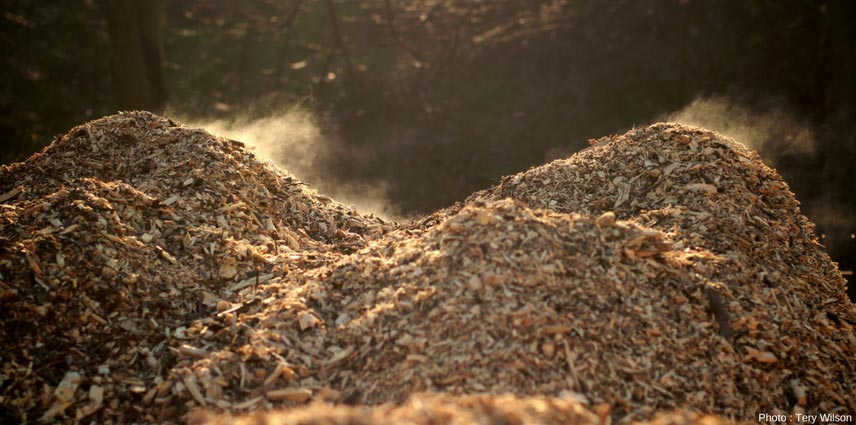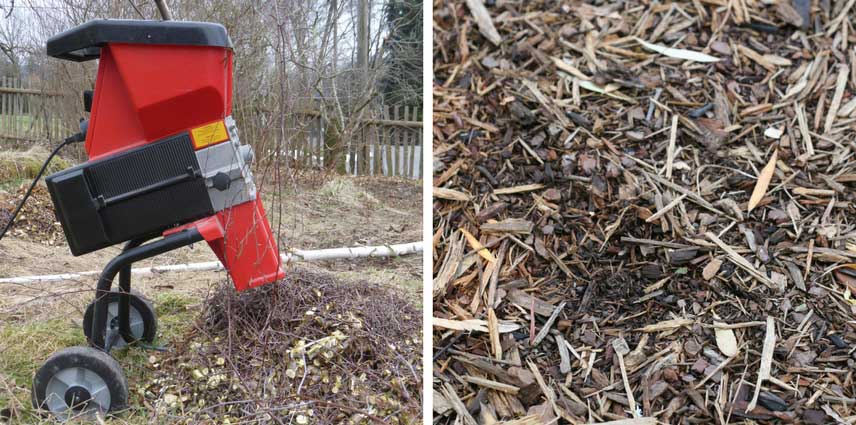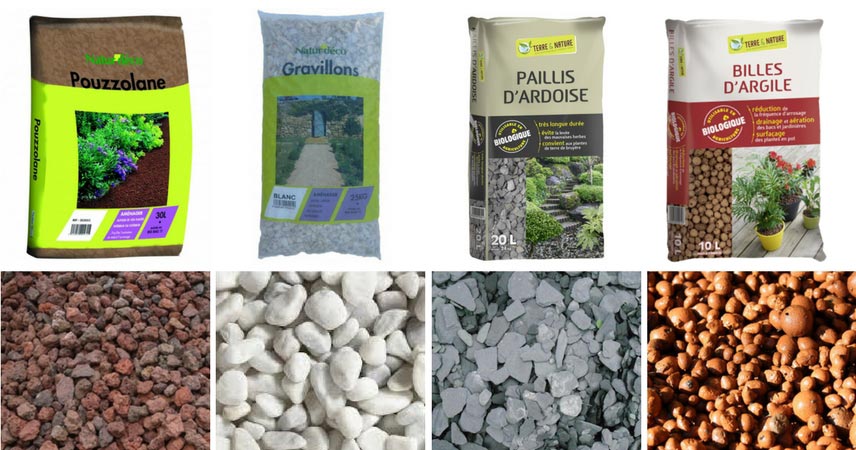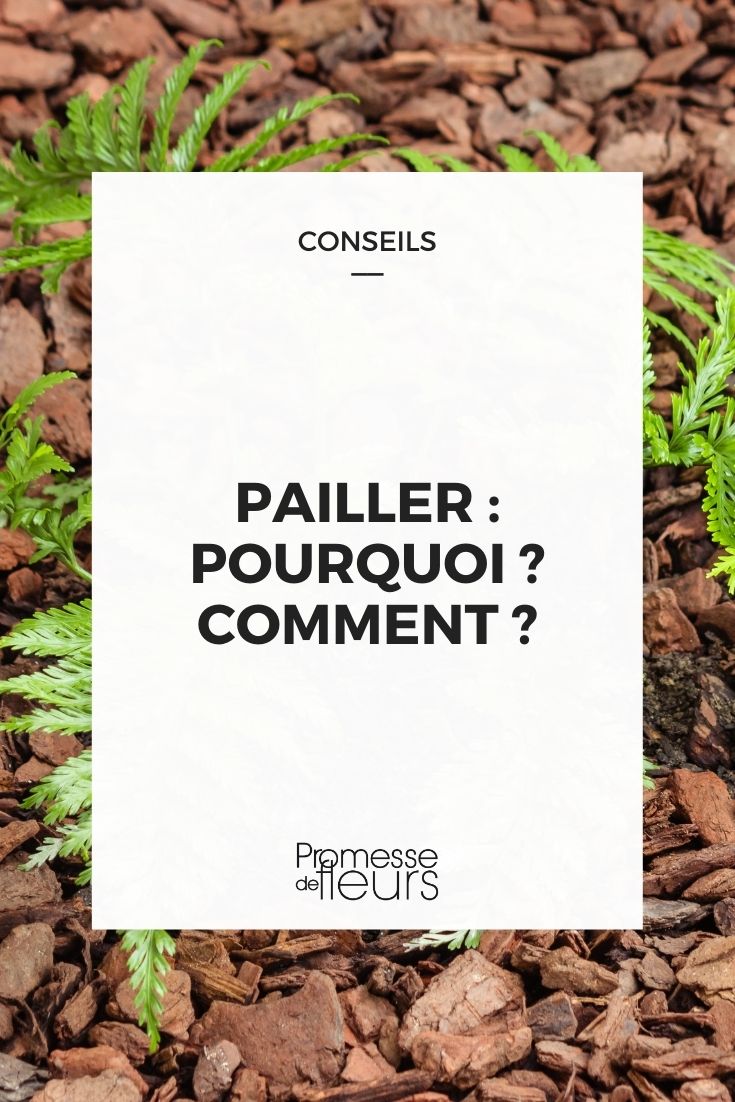
Mulching: Why? how?
And which mulch to use?
Contents
Mulching, also referred to as “mulch,” is a technique increasingly used in gardens and vegetable plots due to its benefits for soil and plants. What is the purpose of mulching? What are the different types of mulch? What is the best mulch for each situation? When and how should it be installed in the garden? Here are many questions we will strive to answer!
What is the purpose of mulching?
Covering bare soil surfaces (between plants in a bed, at the base of trees and bushes…) with mulch allows you to:
- Reduce surface erosion caused by rain and wind, which leads to the formation of a crust on top of the soil. This crust, sometimes referred to as “crust of compaction”, hinders water penetration.
- Slow the development of “weeds”, particularly annuals that cannot germinate without light under the mulch layer… This is even more effective if you take care to clean the surface before spreading the mulch!
- Limit evaporation from the surface during dry periods and, conversely, retain coolness in the soil. This helps save water in summer and reduces the frequency of watering!
- Act as an insulating “mattress” or “duvet” on the soil surface by protecting plant roots from heat in summer and cold in winter.
- Depending on the material used, for example green waste (pruning, mowing, fallen leaves), mulch, as it decomposes gradually, can also enrich the soil with nutrients.
- Add a neat finish to your garden or even a decorative touch if you combine different mulches or opt for coloured mulches.
There are essentially two types of mulch: organic mulches and mineral-based mulches.

A pile of chipping pruning – A heat release is often observed… This is quite healthy as it eliminates potential diseases, but remember to clear the collars of the plants when applying the mulch.
The main commercial organic mulches
Bark mulch, hemp or flax mulch, wood chips… organic mulches are very varied. You can easily find in stores:
- Pine bark
Pine bark is commonly available in different grades, in bags or loose. It is a long-lasting mulch as it decomposes slowly. Moreover, it has an acidifying effect on the soil in the long term. Therefore, it is an ideal mulch for heather soil trees and bushes, which do not mind acidic soils. It can also be used to cover uncultivated areas such as paths.
⇒ Pine bark: uses, advantages and disadvantages
- Hemp mulch, flax mulch and miscanthus mulch
Hemp, flax, and miscanthus mulches are appealing due to their light colour, which enhances the appearance of plants in borders. They are neutral, lightweight mulches that spread easily but decompose quickly, in about two years. They are generally found in bags. They are particularly well-suited for mulching the bases of perennial or annual plants as well as for small vegetable gardens. They incorporate into the soil at the end of their life by simple raking.
- Wheat straw
This is the “original” material, traditionally used in vegetable gardens but also to protect the most tender plants in winter. It is somewhat difficult to find in stores and more readily available in the countryside. However, if it comes from a nearby farm, it is more often offered in round bales than in small bundles. Economical and decomposing quickly, straw is perfect for the vegetable garden, but it is a rather low-density material that allows weeds to pass through easily if not spread in a thick enough layer. When straw is chopped beforehand, it is much more effective for covering the soil. In the garden, you can use it to mulch your borders and the bases of trees and shrubs. In terms of style, the appearance is undeniably “rustic”… charming in a natural garden, but a bit less so in more contemporary spaces.
- Wood chips and wood flakes
These two materials differ in their size: fine for wood chips, coarser for wood flakes. They are made from sawmill waste and consist of hardwoods or softwoods and are sometimes offered in a coloured version, dyed with water-based dyes. Wood chips are lightweight and decompose quickly, while wood flakes have a longer lifespan. They can be purchased in bags or loose. Note that many tree surgeons now shred their waste on-site: do not hesitate to contact them, as they may be able to offer you large volumes of shredded wood or flakes at a reasonable price. Wood chips are mainly used in perennial borders, while wood flakes are more versatile and can also be used to mulch the bases of hedges or trees.
- Coconut husks
Coconut husks are a product derived from the waste of the agri-food industry. They come in the form of small pieces measuring 1 to 2 centimetres, quite heavy and dense. This mulch has the advantage of not blowing away, decomposing very slowly, and not moulding. Dark brown, it is very ornamental and well-suited for Mediterranean plants as well as for mulching garden paths.
- Cocoa shells
Cocoa shells come from the shells that contain cocoa beans. Its smell is indeed characteristic! Neutral, this mulch generally decomposes within a year and nourishes the soil. They are mainly used to mulch borders and flower beds. However, this mulch is not recommended if you have a dog that tends to taste everything. Indeed, this mulch contains theobromine, a plant alkaloid that is toxic to dogs.
- Buckwheat husks
Buckwheat husks are among the finest mulches. They are quite easily found in the West, among galette enthusiasts! With a lovely glazed brown colour, this mulch is perfect for pots and small, well-kept borders. It is also used in the vegetable garden as it is reputed to be less appreciated by slugs, which find it difficult to move on. It gradually decomposes over two to three years and incorporates into the soil.
The range of mulches is constantly evolving. You can also find natural and original mulches: apricot, peach, and hazelnut shells are available online.
 Pine bark, wood chips, miscanthus flakes, and buckwheat husks: organic mulches
Pine bark, wood chips, miscanthus flakes, and buckwheat husks: organic mulches
→ Discover all our organic mulches
Mulches or mulch made from garden waste
Buying mulch is convenient, but it can be relatively expensive. The most economical and natural solution is to use plant materials from the garden for mulching. Almost anything can be transformed into mulch.
- Grass clippings Once dried in the sun, grass clippings are ideal for mulching the vegetable garden. They decompose quickly and provide nitrogen to plants that particularly need it in spring. However, do not spread wet grass in thick layers: a compact, slimy, and foul-smelling mass would form. This fermentation is not beneficial for the plants! If you cannot wait for the grass to dry, spread it in thin successive layers.
- Shrub pruning waste Pruning hedges often generates a lot of waste. Instead of disposing of it, run it through a shredder! Depending on the season, you will obtain slightly different mulch. If you prune deciduous shrubs in winter, you will get a dry mulch that will last for several years. If you prune evergreen shrubs or deciduous shrubs in late spring or summer while they are in leaf, you will obtain greener mulch: this is Ramial Chipped Wood, an excellent mulching material!
→ to read on the subject: “What is BRF? How to use it in the garden” and “Garden shredders: usefulness, different models, choices”

- Pruning waste from perennial and annual plants When you cut back your annuals, perennials, and grasses in autumn or spring, you can leave them in place. To improve their aesthetic appearance, roughly cut them with pruning shears or spread them out and then run the mower over them. This waste will decompose quickly and form an excellent maintenance mulch.
- Dead leaves This is a valuable resource in the garden that would be a shame to waste by taking them to the tip! Spread them out in autumn, of course; they are excellent material for flower beds, around trees, and in the vegetable garden. To learn all about using dead leaves in the garden, check out our advice sheet: “Dead leaves, how to use them in the garden” as well as Olivier’s video on the subject: Using dead leaves well – Video tutorial
- Garden compost Coarse and not quite mature compost can be spread as a nutritious mulch: it will complete its decomposition on the soil surface and nourish the earth in one go.
Mineral mulches, a special case
Mineral mulches are most often made up of gravel, pebbles, crushed slate, or pumice.
Decorative, they are highly valued in small gardens and contemporary flowerbeds. They limit the appearance of adventive plants and help keep the soil cool in summer, but being inert, they do not nourish the soil as an organic mulch would.
They are recommended in a few specific cases:
- in rockeries or raised beds, to insulate the collar of alpine plants from winter moisture and retain some coolness in summer,
- in Mediterranean gardens where the plants present, if adapted, prefer dry and poor soils,
- to create a dry garden, on gravel or to recreate a limestone-type medium.

Pumice, gravel, slate mulch, and clay balls
Note that the term mulch cloth is sometimes used to refer to planting tarps used in certain landscaping arrangements. They are developing in gardens but are not very aesthetic. To learn more, check out our article on the subject: “Mulch cloth: for or against?”
→ Discover all our mineral mulches
What is the best mulch?
We are often asked what is the best mulch. It’s quite simple: the best mulch is an appropriate mulch. To choose a mulch, you need to consider two essential criteria:
- the needs of the plants,
- the lifespan of the mulch.
1) Choosing a mulch based on the plants
Indeed, not all plants have the same needs, so it is important to choose an appropriate mulch. Some plants prefer moist, humus-rich soils, while others thrive in dry, poor soils. Similarly, heather soil plants like Rhododendrons, Hydrangeas, and small red fruits… enjoy acidic soil. Others, like Phlomis, can tolerate or even prefer calcareous soils. For the former, a mulch like pine bark is perfect. Nutrient-rich mulches that decompose quickly will also be a good choice for plants that enjoy rich soil. Conversely, frugal plants that love heat will be comfortable with a mineral mulch.

These two beds with similar tones have different needs: the first will appreciate a mulch that retains moisture, while the second will prefer a mineral mulch.
2) Choosing a mulch based on its lifespan
The lifespan of the mulch is also a consideration: you do not mulch the base of a hedge with the same materials as the rows of a vegetable garden. For the base of trees and bushes, opt for a mulch with a large particle size and a long lifespan, such as wood chips: you will be set for several years. For flower beds, a finer mulch like homemade chippings or linseed and miscanthus flakes is very aesthetic. Finally, in the vegetable garden, dry grass and fallen leaves are ideal as they nourish the soil life and “melt” away like snow in the sun, leaving plots almost ready to be planted in spring.

To mulch a path or the base of a hedge, choose a long-lasting mulch. Conversely, in the vegetable garden, opt for a mulch that will decompose quickly and nourish the soil.
⇒ Also read our tips: What mulch for the vegetable garden?
When and how to mulch?
1) When to mulch?
Mulching can be done all year round. When creating a flower bed or planting a hedge, mulch immediately after planting to prevent unwanted herbs from settling in (this happens very quickly). However, the two most favourable times for mulching are spring and autumn.
- Spring Mulching:
It primarily aims to save on watering by retaining moisture in the soil and to limit weeding by slowing the growth of weeds. It is preferably done between mid-April and mid-May, when the soil is already a bit warmed up and has not yet suffered from drought. You can then, during the summer, top up the thickness of the mulch layer.
- Autumn Mulching:
Autumn mulching is done before the frosts, around mid-autumn, for example during the cleaning of the flower beds at the end of the season. Spread before winter, mulching always serves to prevent the growth of weeds, but its essential role in winter is to provide an insulating layer protecting the roots from the cold. It also helps to protect less hardy plants. A thick layer of straw or dead leaves is perfect in this specific case.
Read also: Which Mulch to Choose to Protect Plants from the Cold?
2) How to mulch?
Mulching is a simple operation, but a few precautions are necessary:
- Before mulching, start by thoroughly cleaning your flower bed or vegetable plot, hoeing, and then watering if the soil is dry. Then spread the material on the surface of the soil, between the plants, ensuring to leave the collar of the plants and the base of the stems clear.
- The ideal thickness is generally between 5 and 7 centimetres. 5 centimetres is a minimum for the mulch to fully perform its role. Note that the coarser the mulch, the more generously you can spread it. Similarly, if your mulch is intended to protect less hardy plants, do not hesitate: the thicker the layer, the better the roots are protected; you can even double the usual thickness of 5 to 7 centimetres.
- If your mulch consists of “fresh” elements like grass, mulch in several stages, in thin successive layers.
- If you are using fresh chippings, be particularly vigilant: spread in a thick layer, it can heat up. Clearing the collars of the bushes, at least initially, is very important.
- Never mulch on a dry soil, otherwise the mulch will further hinder water penetration. In dry periods, start with a generous watering before spreading the mulch.
- Do not mulch on frozen soil, as the mulch would then have the opposite effect of what is desired… keeping the cold in the soil!
→ Read also: How to Properly Implement Mulching?
7 Frequently Asked Questions About Mulching
- Should I remove the mulch?
Removing the mulch is generally not necessary except in the vegetable garden.
In flower beds, at the base of hedges or trees, simply add a layer of mulch to renew it. If you usually work the soil a bit in spring and have mulched with well-decomposed organic material, you can incorporate this organic matter into the soil by scratching it in, then spread a new layer of mulch. Otherwise, do not bury it but clear the mulch layer and place it on the compost heap where it will finish decomposing.
In the vegetable garden, if there is still mulch on the plots at the beginning of the season (February, March), it is advisable to remove it so that the soil can “dry out”, meaning it dries a bit and can be worked more easily and safely before sowing. Removing the mulch will also allow the soil to warm up more quickly with the first sunny days. Any excess mulch can be added to the compost or used to mulch a flower bed.
- It is said that mulching causes yellowing of leaves, is that true?
Yes, this can occasionally happen but it is quite rare and only concerns young plants. This phenomenon is called “nitrogen hunger”. It occurs if you bury poorly decomposed material because, in the soil, microorganisms will use the nitrogen from the soil for this decomposition. It can also happen if you use a rather carbonaceous mulch (made up of woody elements like wood chips or shredded dry branches). It is very easy to avoid nitrogen hunger by placing a layer of mature compost at the base of the plants just before mulching.
→ to read more: “Nitrogen hunger: what is it? How to avoid it, remedy it?”
- My mulch doesn’t stay in place and ends up on the grass, what can I do?
Some lightweight materials like wood chips or flax or hemp flakes tend to blow away at the slightest gust of wind. To prevent this, water the mulch just after laying it down to “settle” it. Another tip is to dig the planting area 10 cm below the lawn level when creating the bed. Cut the bed edge well: once the soil is mulched, everything will be at the same level and the mulch will no longer slide onto the lawn!
- Mushrooms are growing on my mulch, is that normal?
Yes, this is perfectly normal and neither dangerous nor concerning: it is proof that life is developing on and in your soil.
- I used to mulch my vegetable garden but a friend told me it attracts slugs and voles…
Mulching does indeed have this reputation. However, this would not be entirely accurate. In fact, slugs are more visible when there is mulch because they reside there. But they are just as numerous, only less visible in plots without mulch as they then take refuge in the soil. It should also be noted that mulches provide a favourable environment for slug predators: rove beetles that eat the eggs. Therefore, mulching would be more conducive to a balance in slug populations.
Regarding rodents, yes, mulching is favourable to them if they were already present in the garden. Prefer finer mulches or those spread in thin layers over “fluffy” materials like straw.
- Blackbirds are turning over and moving my mulch, what should I do?
Indeed, this is one of their favourite activities in winter and early spring… You can try placing a scarecrow but they are clever and cause little damage in the end. Moreover, like with mushrooms, their presence is a good sign: it proves that there are earthworms under the mulch! A quick rake now and then will quickly restore order in your beds.
- I spread gravel in my small Mediterranean bed but it is mixing with the soil…
This is one of the drawbacks of this type of mulch. The ideal with mineral mulches is to intersperse a geotextile fabric between the soil and the mulch so that the different layers do not mix.
To go further
Discover:
- Our article on decorative mulches: they add style to the garden
- Our article: What mulch for a slope or a raised bed?
- Subscribe!
- Contents
































Comments